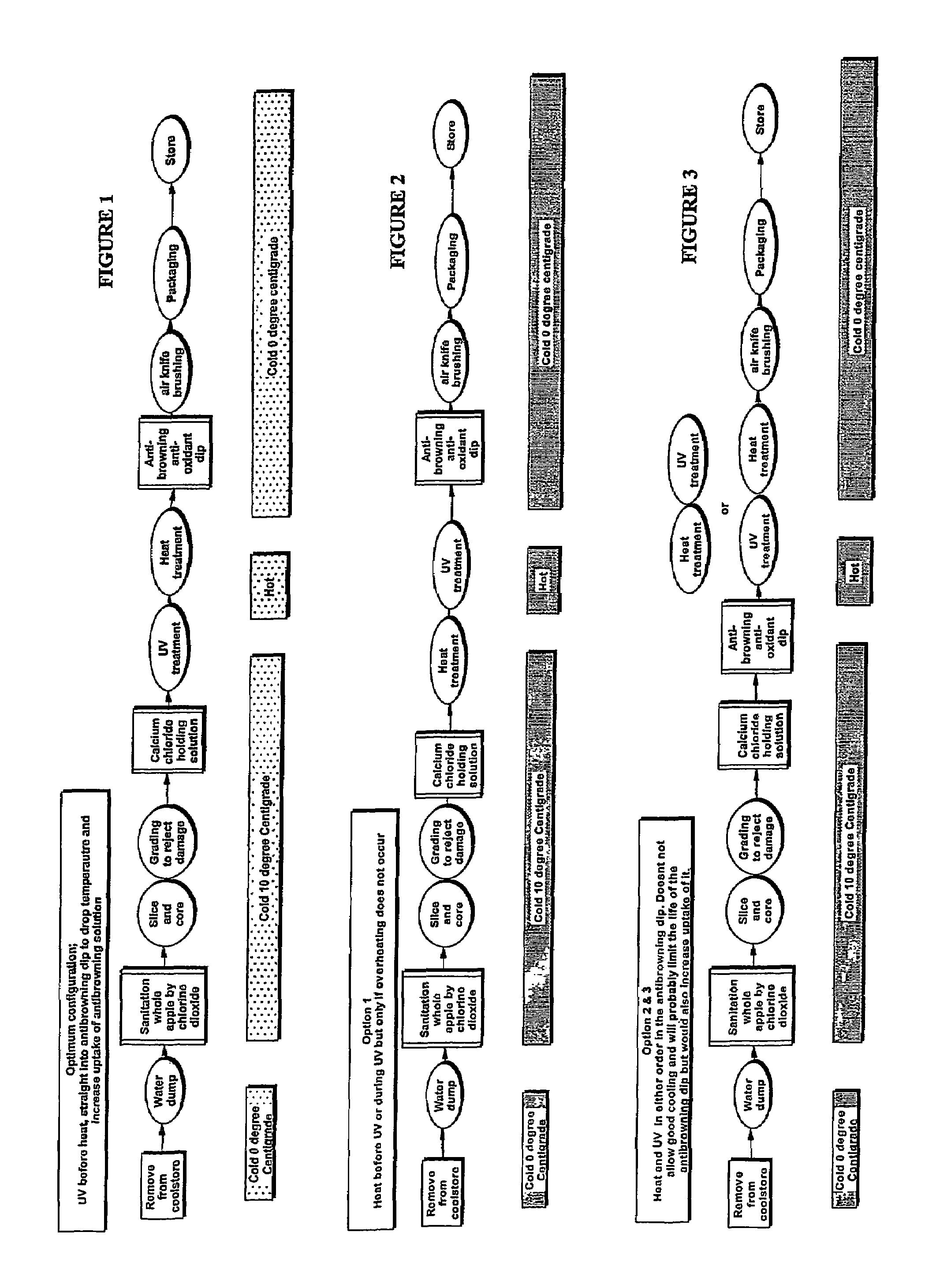Preservation of produce
a technology for preserving produce and produce, applied in the field of preserving produce, can solve the problems of insufficient, adversely affecting taste, texture, visible spoilage and food safety, and deterioration of fresh fruit and fresh vegetables in most conditions, and achieves low tpc level, inhibit visible microbial spoilage, and low to zero visual microbial spoilage
- Summary
- Abstract
- Description
- Claims
- Application Information
AI Technical Summary
Benefits of technology
Problems solved by technology
Method used
Image
Examples
example 1
Effect of UV and Heat Treatment on the Microbial Count of Braeburn Apple Slices
[0133]
Heat TreatmentUV treatmentHeatMicrobial countUV6 minutesDIP calciumTPCTreatment50 sec50° C.ascorbate (% w / w)22° C.Code0.1% CaCl20.1% CaCl28%cfu / gS2-No UV / HeatX80S3-UV but NoXX60HeatS4-UV and HeatXXX
[0134]Conclusion: It can be seen that the combination of UV and heat in Treatment S4 gave the lowest microbial count.
example 2
Determination of Maximum Heating Time of Braeburn Apple Slices to Maintain an “As Fresh” Appearance Apple Slice.
[0135]Braeburn apples were prepared by the usual method and heat treated at different times and temperatures as in the Table. A thermocouple was inserted into a slice in every run to record the temperature at the thickest part of the slice. All slices were dipped into cold 8% calcium ascorbate, drained and stored in zip lock polyethylene bags at 8° C.
[0136]Method of assessment: Apples (3 per treatment) in triplicate were visually assessed up to 25 days storage and the presence of any discoloration or visible microbial spoilage in the bag was rated as unacceptable.
[0137]
MaximuminternalResult DaysVariablestemperatureat 8° C. Heatingin slicethat sliceTemperatureafter heatingappearance wasTreatment0.1% CaCl2TimeTemperature“as fresh”Name° C.minutes° C.Average (limits)Control a 00— 8.86 (8-10)A1a5012510.00 (6-12)A2a50234.5 4.33 (1-6)A3a50437.2 7.00 (3-10)A4a50645 8.33 (1-18)A5a5...
example 3
Effect of UV and Heat on Microbial Count After Storage at Different Temperatures
[0140]Braeburn apples were treated for 30 seconds with UV and then heat treated at the defined temperatures in the table and dipped for 2 minutes in 8% calcium ascorbate. After storage in sealed polyethylene bags for the stated time the samples were tested for microbial contamination using a total plate count (TPC) procedure at 22 ° C.
[0141]The samples were independently assessed by a panel of 4 people for acceptable taste and appearance.
[0142]
HEATINGDIPTempTime8%Microbial count° C.minutesCalciumTPCTREATMENTin 0.1% CaCl2ascorbatecfu / gmStorage0 004 4 4888temperature° C.Storage time016210162101621DaysControlNo heat2XXna1300Xna23,000 naX1,700250,000SAMPLE 1502XXna10Xna 760 naX6,9001,300,000(S1)SAMPLE 2552XXnaXnaX68,00011000(S2)
Results: Microbial Counts
[0143]A combination of UV and heat treatment was able to substantially eliminate microbial growth compared to the control when stored at 0 degrees for up to ...
PUM
 Login to View More
Login to View More Abstract
Description
Claims
Application Information
 Login to View More
Login to View More - R&D
- Intellectual Property
- Life Sciences
- Materials
- Tech Scout
- Unparalleled Data Quality
- Higher Quality Content
- 60% Fewer Hallucinations
Browse by: Latest US Patents, China's latest patents, Technical Efficacy Thesaurus, Application Domain, Technology Topic, Popular Technical Reports.
© 2025 PatSnap. All rights reserved.Legal|Privacy policy|Modern Slavery Act Transparency Statement|Sitemap|About US| Contact US: help@patsnap.com


